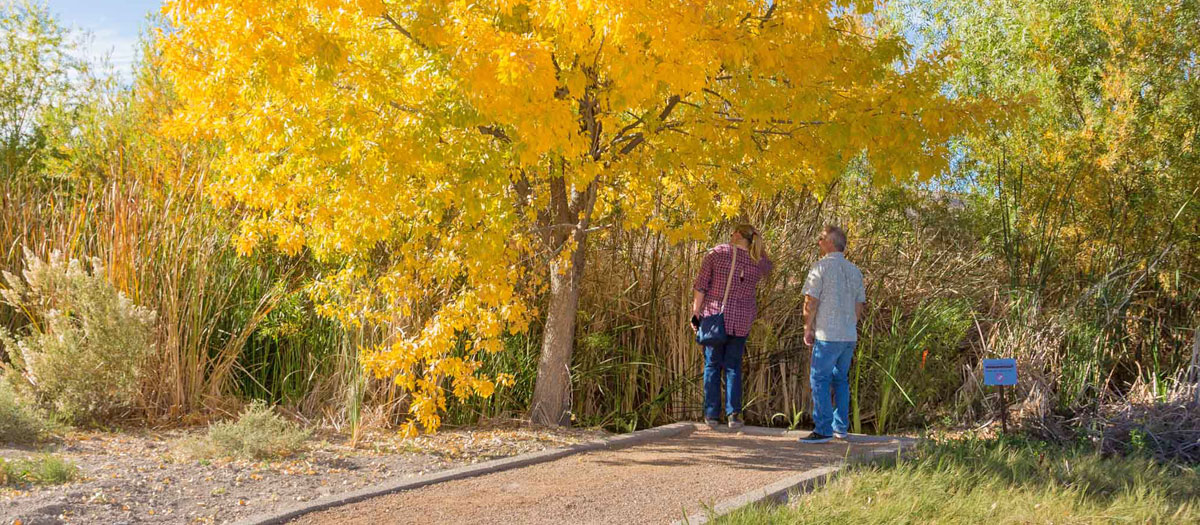Warm Springs Natural Area is a 1,250-acre oasis in Moapa, Nevada featuring more than two dozen bubbling springs, rushing streams and lush wetlands. It is also home to over 28 sensitive species and more than 200 species of birds. Operated by the Southern Nevada Water Authority, our mission is to manage the property as a natural area for the benefit of native species and for the recovery of the endangered Moapa dace.

Free guided walking tours in fall
Spend a Saturday at Warm Springs!
Join us for a free, guided tour of the Warm Springs Public Use Area this fall. Tours are approximately one hour long and begin at 10 a.m. Upcoming tour dates:
- Sept. 20
- Oct. 4
- Nov. 15
- Dec. 20

Volunteer opportunities
Warm Springs Natural Area is seeking enthusiastic individuals who are passionate about the outdoors and thrive on educating others! Come engage visitors at our public use area, help at local events, assist staff during field trips and other hosted activities, work in the greenhouse and on restoration projects, and teach the community about our rich history and current preservation efforts and biological, ecological, and archaeological research.
Become a docent2023 Highlights
- Engaged with more than 1,470 people during community outreach events, tours, and presentations.
- Continued partnership with Future Farmers of America program at Moapa Valley, engaging students in wildlife and property management activities.
- Hosted 110 fifth-graders from Grant Bowler Middle School for annual World Wetlands Day event.
- Held annual community Green-Up event that brought 207 volunteers to the property to plant 2,677 native shrubs and grasses.
- Spent more than 2,650 hours completing 12 Scout projects that included 285 volunteers installing 1,412 native trees and shrubs.
- Volunteers completed more than 200 hours in plant propagation projects in the Greenhouse and Shade Structure on property.
- Completed tours for more than 140 guests for groups including Red Rock Audubon, Friends of Gold Butte, Girl Scouts of Southern Nevada, Las Vegas Lions Club, and more.
- Logged more than 165 groups and over 485 individuals in the guestbook.
- Hosted Spring and Fall tours bringing more than 225 people to the property.
- Continued to implement compliance measures to protect threatened and endangers species per the Incidental Take Permit authorized by the U.S. Fish and Wildlife Service.
- Conducted Moapa dace counts, snorkeling more than 6 miles of streams for each count. Numbers remain stable with 1,935 Moapa dace counted in February 2024 and 2,110 counted in August 2024.
- Identified 25 Virgin River chub on property during the February dace count and 23 during the August 2024 dace count.
- Continued annual marsh bird surveys, detecting Virginia rail and sora.
- Documented two southwestern willow flycatcher (endangered) fledglings.
- Reported three detections of yellow-billed cuckoo (threatened).
- Hosted two Muddy River Audubon Christmas Bird Counts on Dec. 29, 2024 with 19 participants counting 83 species and 16,396 total birds.
- Documented two desert tortoises on property.
- Sampled benthic macroinvertebrates at the fish barrier.
- Added several new terrestrial invertebrates to the inventory, including some possible state records, bringing the total to 527.
- Conducted a monarch survey documenting four caterpillars and two adult monarch on the property.
- Published documentation of the first account in Nevada of the six-spined orbweaver spider in the October 2024 edition of The Pan-Pacific Entomologist.
- Conducted a small mammal survey along the banks of the Muddy River, capturing desert pocket mouse, cactus mouse, and desert woodrat.
- Documented a Ticul's shrew which represents the first shrew on property and the first shrew record for Northeast Clark County.
- Coordinated with U.S. Geological Survey and Clark County to collect genetic samples and determine if there are Arizona toad hybrids on property.
- Worked with the Spring Stewardship Institute to conduct detailed hydrologic and biotic surveys on nine springs.
- Actively participated in the Muddy River Biological Advisory Committee monthly meetings.
- Treated 7.72 acres of noxious weeds and 20 acres of bare ground for firebreaks from January through October.
- Removed one acre of tamarisk along the State Route 168.
- Produced more than 6,600 native trees, shrubs, forbs, and grasses in the onsite propagation facility for future restoration efforts.
- Installed 4,100 native plants and associated irrigation systems at six ecological restoration sites.
- Cleared vegetation from 1.4 miles of streams to improve Moapa dace habitat.
- Prepared plans and started work at restoration sites funded by the Bureau of Land Management and Bureau of Reclamation.
- Continue to treat and remove noxious weeds and fuel reduction efforts throughout property.
- Continue maintenance of fire breaks.
- Conduct herpetelogical survey of the property.
- Continue to engage with local schools, delivering in-classroom presentations and bringing students to the property for field trips.
- Continue spring and fall Public Use Area tours for the general public and tours for interested groups.

